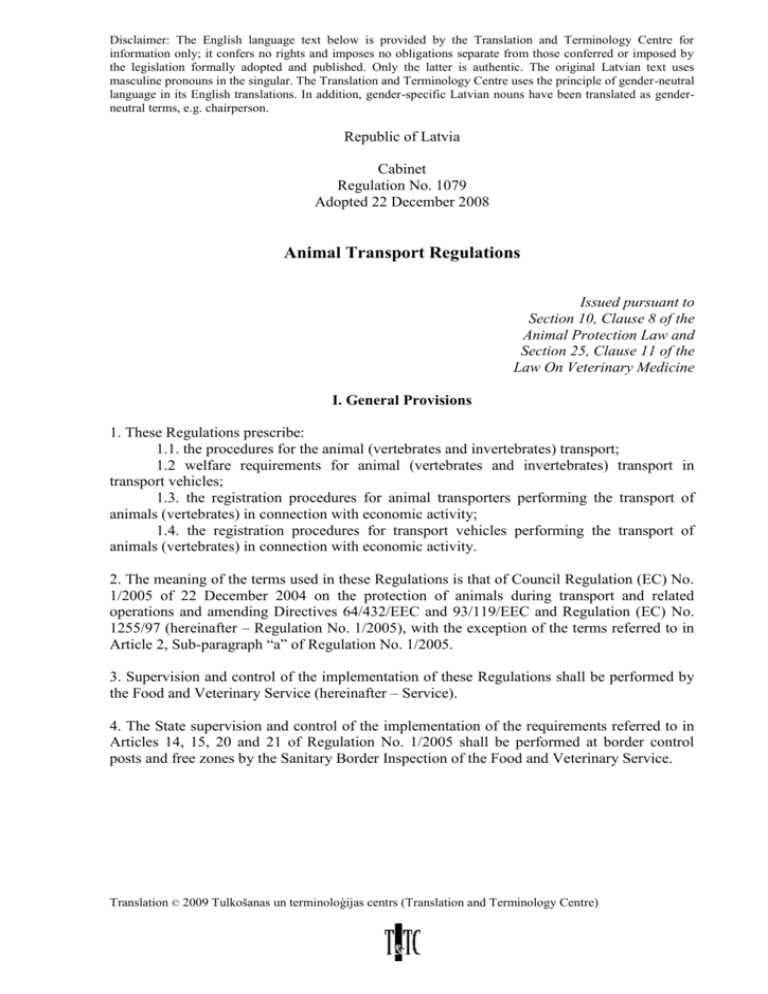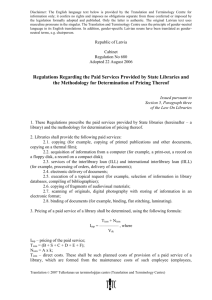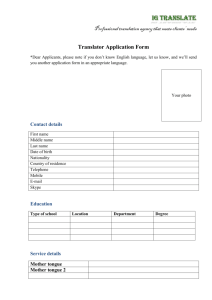Cab._Reg._No._1079_-_Animal_Transport_Regulations
advertisement

Disclaimer: The English language text below is provided by the Translation and Terminology Centre for information only; it confers no rights and imposes no obligations separate from those conferred or imposed by the legislation formally adopted and published. Only the latter is authentic. The original Latvian text uses masculine pronouns in the singular. The Translation and Terminology Centre uses the principle of gender-neutral language in its English translations. In addition, gender-specific Latvian nouns have been translated as genderneutral terms, e.g. chairperson. Republic of Latvia Cabinet Regulation No. 1079 Adopted 22 December 2008 Animal Transport Regulations Issued pursuant to Section 10, Clause 8 of the Animal Protection Law and Section 25, Clause 11 of the Law On Veterinary Medicine I. General Provisions 1. These Regulations prescribe: 1.1. the procedures for the animal (vertebrates and invertebrates) transport; 1.2 welfare requirements for animal (vertebrates and invertebrates) transport in transport vehicles; 1.3. the registration procedures for animal transporters performing the transport of animals (vertebrates) in connection with economic activity; 1.4. the registration procedures for transport vehicles performing the transport of animals (vertebrates) in connection with economic activity. 2. The meaning of the terms used in these Regulations is that of Council Regulation (EC) No. 1/2005 of 22 December 2004 on the protection of animals during transport and related operations and amending Directives 64/432/EEC and 93/119/EEC and Regulation (EC) No. 1255/97 (hereinafter – Regulation No. 1/2005), with the exception of the terms referred to in Article 2, Sub-paragraph “a” of Regulation No. 1/2005. 3. Supervision and control of the implementation of these Regulations shall be performed by the Food and Veterinary Service (hereinafter – Service). 4. The State supervision and control of the implementation of the requirements referred to in Articles 14, 15, 20 and 21 of Regulation No. 1/2005 shall be performed at border control posts and free zones by the Sanitary Border Inspection of the Food and Veterinary Service. Translation © 2009 Tulkošanas un terminoloģijas centrs (Translation and Terminology Centre) II. Procedures for the Transport of Animals 5. The following documents shall be necessary for transporting animals in the territory of Latvia: 5.1. all livestock – a livestock transport declaration, as well as: 5.1.1. for horses – a horse passport; 5.1.2. for cattle – a cattle passport; 5.2. for domestic (household) animals – a vaccination certificate or a domestic (household) animal passport; 5.3. for circus animals – a circus animal or training number animal passport; 5.4. for wildlife species animals – a written attestation by the animal owner containing the following information: 5.4.1. the animal’s origin (obtained in captivity or from the wild (indicating the place), state from which it was imported); 5.4.2. the animal owner (given name, surname or name and address); 5.4.3. the place and date of departure of the animal; 5.4.4. the planned final destination and expected duration of the transportation; 5.4.5. feeding, drinking and any other necessary special welfare requirements for the animal. 6. A veterinary (health) certificate and other documents prescribed in regulatory enactments regarding veterinary control shall be necessary when bringing an animal into or out of the territory of Latvia, with the exception of domestic (household) animals referred to in Regulation No. 998/2003 of 26 May 2003 of the European Parliament and of the Council on the animal health requirements applicable to the non-commercial movement of pet animals and amending Council Directive 92/65/EEC. 7. In addition to a veterinary (health) certificate, an authorisation shall be necessary in order to bring the following wildlife species animals into the territory of Latvia: 7.1. the wildlife species animals referred to in regulatory enactments regarding hunting regulations; 7.2. the wildlife species animals uncharacteristic to Latvia referred to in the regulatory enactments regarding animal protection; 7.3. the animals referred to in Council Regulation (EC) No. 338/97 of 9 December 1996 on the protection of species of wild fauna and flora by regulating trade therein. 8. The animal to be transported shall be registered and labelled according to the prescribed procedures of regulatory enactments regarding registration and labelling. 9. A transport vehicle, which in connection with economic activity transports animals (vertebrates), shall have placed on it the label “Dzīvi dzīvnieki” (Live Animals) (Annex): 9.1. on a motor vehicle – on the top right hand corner of the front windscreen and on the rear doors or window; 9.2. on other transport vehicles – on the compartment doors, in which animals are placed. Translation © 2009 Tulkošanas un terminoloģijas centrs (Translation and Terminology Centre) 2 III. Welfare Requirements for the Transport of Animals, Which are not Associated with an Economic Activity, and the Transport of Animals (Invertebrates) 10. An animal owner or keeper shall ensure the following: 10.1. measures which decrease the duration of the transport to a minimum and satisfy the needs of an animal during the time of transportation; 10.2. the suitability of the animal for transportation; 10.3. the appropriateness of the transport vehicle’s construction, maintenance and operation thereof, in order to prevent the animal from being injured and suffering, as well as guarantee the safety of the animal; 10.4 the appropriateness of the construction of the loading and unloading facility, maintenance and operation thereof, in order to prevent the animal from being injured and suffering, as well as guarantee the safety of the animal; 10.5. training of or the competence of the person caring for the animal’s welfare, so that they perform their duties without coercion and do not utilise methods which could cause unnecessary fear, injury or suffering to the animal; 10.6. regular monitoring of the welfare conditions of the animal; 10.7. the animal has sufficient area and height suitable to its natural behavioural (ethological) requirements; 10.8. watering, feeding and resting of the animal at intervals, in the quality and amount appropriate to the animal’s species; 10.9. restriction of the animal in the transport vehicle, so that the transport of the animal does not interfere with road traffic users. 11. If the animal’s owner is not present during transport, then there shall be written instructions submitted by the owner regarding feeding, watering and any other necessary special care of the animal. Written instructions regarding feeding, watering and any other necessary special care shall not be required for registered animals of the horse family, cattle, sheep, goats or pigs. 12. When transporting domestic (household) animals on public transport vehicles: 12.1. a dog shall be muzzled, held on a leash or placed in an appropriate case, container or cage; 12.2. other domestic (household) animals shall be placed in appropriate cases, containers or cages. 13. An animal shall not be left unattended in a transport vehicle if that can possibly threaten the health or life of the animal. IV. Welfare Requirements for the Transport of Animals (Vertebrates) in Connection with an Economic Activity 14. Animals shall be permitted to be transported in connection with economic activity, if: 14.1. transport of the animal complies with the requirements of Regulation No. 1/2005; 14.2. an animal transporter certificate has been obtained: 14.2.1. for short journeys which do no last longer than eight hours and take place in the territory of the European Union; 14.2.2. for long journeys which are longer than eight hours and take place to a state which is not a Member State of the European Union; Translation © 2009 Tulkošanas un terminoloģijas centrs (Translation and Terminology Centre) 3 14.3. the transport vehicle has received an authorisation for animal transport. V. The Registration Procedures for Transporters and Transport Vehicles Which Perform the Transport of Animals (Vertebrates) in Connection with Economic Activity 15. In order to receive an animal transporter authorisation (certificate) or authorisation to transport animals for transport vehicles in accordance with Regulation No. 1/2005, a person shall submit an application to the territorial structural unit of the Service. The following information shall be indicated in the application: 15.1. name, registration number, address and telephone number of a legal person or a natural person’s given name, surname, personal identity number, address and telephone number; 15.2. the type of animal transport (short, long); 15.3. animal species to be transported. 16. The Service shall, within a period of two weeks, examine the application and issue the animal transporter certificate, if the person: 16.1. has satisfied the requirements of Regulation No. 1/2005; 16.2. has received a qualification certificate regarding knowledge of animal transport; 16.3. has paid the State fee for the issue of the animal transport certificate. 17. The Service shall, within a period of two weeks, examine the application and issue an authorisation for a transport vehicle to transport animals, if: 17.1. the vehicle complies with the requirements of Regulation No. 1/2005; 17.2. the transport vehicle owner has paid the State fee for the issue of the authorisation to the transport vehicle (transport vehicle or container) to transport animals. 18. The Service shall develop and maintain in the State veterinary supervisory objects data base a transporters and transport vehicles register with the following information: 18.1. on a person, which has received an animal transporter’s certificate: 18.1.1. the name, registration number, address and telephone number of a legal person; 18.1.2. the given name, surname, personal identity number, address and telephone of a natural person; 18.1.3. certificate number, date of issue, place of issue, term of validity and type of certificate (for short or long journeys); 18.1.4 penalties applied to the transporter regarding infringements in animal transport; 18.2. on a transport vehicle, which has received an authorisation to transport animals: 18.2.1. type of transport vehicle; 18.2.2. certificate number, date of issue, place of issue, term of validity and type of certificate (for short or long journeys); 18.2.3. the transport vehicle owner (name, registration number, address and telephone number of a legal person or a natural person’s given name, surname, personal identity number, address and telephone number); 18.2.4. State registration number of the transport vehicle (trailer); 18.2.5 penalties applied to the transport vehicle owner regarding infringements in animal transport. Translation © 2009 Tulkošanas un terminoloģijas centrs (Translation and Terminology Centre) 4 19. The information referred to in Paragraph 18 of these Regulations (with the exception of the information regarding the personal identity number and address of a natural person referred to in Sub-paragraphs 18.1.2 and 18.2.3) shall be publicly accessible on the Service’s Internet homepage at www.pvd.gov.lv. 20. Information exchange between competent State authorities regarding observance of the requirements referred to in these Regulations shall be carried out by utilising the integrated computerised veterinary system (TRACES). VI. Closing Provision 21. Cabinet Regulation No. 713 of 16 December 2003 Animal Transport Regulations (Latvijas Vēstnesis, 2003, No. 180) is repealed. Prime Minister I. Godmanis Minister for Agriculture M. Roze Translation © 2009 Tulkošanas un terminoloģijas centrs (Translation and Terminology Centre) 5 Annex Cabinet Regulation No. 1079 22 December 2008 Label “Dzīvi dzīvnieki” (Live Animals) Minister for Agriculture M. Roze Translation © 2009 Tulkošanas un terminoloģijas centrs (Translation and Terminology Centre) 6







